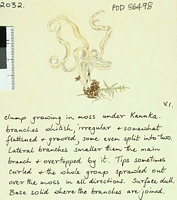|
 Clavulina subrugosa var. tenuis Clavulina subrugosa var. tenuis
BiostatusPresent in region - Indigenous. Endemic
Images (click to enlarge)
Caption: Watercolour
Owner: G.M. Taylor |
Article: Petersen, R.H. (1988). The clavarioid fungi of New Zealand. New Zealand Department of Scientific and Industrial Research, Bulletin 236: 170 pp. Wellington:.
Description: Fruit bodies up to 55 x 5 mm, gracile, simple to branched once or twice, occasionally cristate, off-white to pale ivory ("cartridge-buff") at all ages, never darker than very pale dull yellow ("cream-buff'), solitary, gregarious to cespitose in small (2-5) groups, arising from very small, appressed, white mycelial mats; stipe indistinct, not glabrous. Branches irregular, dichotomous to monopodial, sometimes half the length of the fruit body and then gracile and more or less terete, sometimes represented by an expanded-flattened row of apical crests or a combination of both types; in some collections some bruises slowly turning pallid dull pinkish tan ("pinkish-buff'). Odour none; taste negligible.
Tramal hyphae of upper fruit body hyaline, 3-8 gm diam., clamped, thin- to slightly thick-walled (wall up to 0.3 gm thick), inflated somewhat, more or less parallel; hyphae of subhymenium 5-13 gm diam., inflated, with inconspicuous clamps. Hymenium thickening; basidia 38-60 x 7-8.5 gm, clavate to subclavate, clamped, hyaline, multiguttulate when mature; post-partal septation common but not invariable; cystidia none.
Spores 7.6-9 x 6.1-7.2 Rm (E =1.11-1.32; E'" =1.21; L 8.1 gm), subglobose to broadly ellipsoid, thin-walled, hyaline; contents uniguttulate, refringent under phase contrast; hilar appendix small, papillate.
Habitat: Under both mixed podocarp and Nothofagus forest.
Notes: The various off-white fruit bodies in this genus are confusing, especially in the absence of cystidia. Small basidia and spores help mark this taxon, however, and the fruit bodies seem invariably slender and gracile, even when branched. The bruising reaction seems irregular, being seen only in some fruit bodies of some collections.
I have been tempted to place these collections under Clavulina gracilis Corner, but his description and the type specimen at CGE show that fruit bodies of that taxon are not branched. With so many names already in the literature, I am loath to describe a new species in this group of non-cystidiate clavulinas, especially from the Pacific. Nonetheless, I cannot find a suitable name under which to place these collections. I am drawn to Clavulina subrugosa, with which I am familiar both from Australia and New Zealand for it shares all microscopic characters with these collections, but fruit bodiesof that taxon do not usually show cristate apices, and usually turn to grey shades by maturity. Thus, as a compromise, and with misgivings, I propose a new variety under C. subrugosa.
|